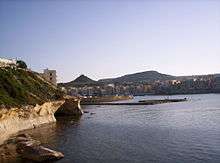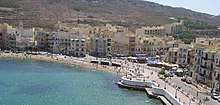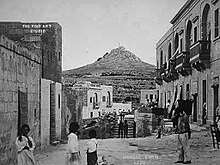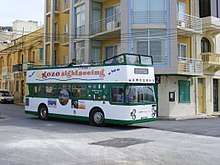Marsalforn
| Marsalforn | |
|---|---|
| Borders | Żebbuġ, Victoria, Xagħra |
| Population | |
| • Estimate (n/a) | 500 to 1,000 |
| Time zone | CET |
| Area code(s) | 356 |




Marsalforn (Marsa el-Forn),[1] also written as M'Forn for shortcut purposes, is a village on the north coast of Gozo, the second largest island of the Maltese archipelago. The village lies between the hill-top towns of Xagħra and Żebbuġ. The village forms part of the locality of Żebbuġ. Marsalforn is one of the most popular tourist resorts on Gozo. It is well served with hotels, guest houses, restaurants, bars, and beaches. There is only a one small sandy beach in Marsalforn, however, along the rocky coastline there are a number of interesting swimming spots. Also, there's only one police station in Marsalforn.
Public structures
- a Roman Catholic church
- a police station
- a major bus stop
- 7 diving centers
- a hotel, a guesthouse and a couple of apartments for rent
- 20 restaurants
- 6 shops and supermarkets
Nature
- a major sandy beach and some swimming spots
- a public garden and a park
Name
Marsalforn is a composite word. "Marsa" is an Arabic word meaning `port` or `bay.` There is disagreement on the origin of the second part of the word - `forn` -. Forn means "a bakery" in Maltese and Arabic, but it is highly improbable that this has anything to do with Marsalforn, for it is unlikely that a bakery would be built in an area with a small population. It is quite likely that this name, like that of other Gozitan ports, might refer to a type of ship. In that case it would derive from Liburna. an Illyrian type of a ship, which became livurna in Greek, and lifurna in Arabic. The name might also have been derived from forna, a word used by Gozitan fishermen to refer to "a cave hollowed out by the sea". There are several of these in Marsalforn, the best known being Għar Qawqla `the cave at the steep hill`.
Emblem
The emblem of Marsalforn consists of a blue shield representing Marsalforn harbour, encircled by a golden border. Saint Paul, according to tradition, left for Rome, after his shipwreck, from Marsalforn; hence the emblem of Saint Paul: a viper encircling the sword. The viper refers to the episode involving Saint Paul just after his shipwreck on Malta as recorded in the Acts of the Apostles.
Geography
To the south of Marsalforn is a fertile valley named after the village. The valley is bounded by several hillocks and used to be known as the "haven of hillocks".[2] The most famous of these is tas-Salvatur (Our Saviours Hill) also referred locally as Tal-Merzuq Hill (Ray of Light) due to the legends surrounding it, recorded by Giovanni Abela in the 17th Century.
This volcano like hill has acquired the attention of the people since 1901, when a large wooden cross was erected on its peak. Three years later, when Gozo was consecrated to Christ the Saviour, a stone statue of Christ replaced the cross. This was in turn replaced by a gigantic concrete statue towering twelve meteres above the hill, which remains to this day.
As recorded in the Acts of the Apostles, Paul the Apostle was shipwrecked in Malta, but legend maintains that it was from Marsalforn that he embarked for Sicily and Rome. Today, this legend is symbolised by the village's emblem, which consists of a viper encircling a sword. This refers to an episode involving Saint Paul when he remained unharmed after being bit by a viper. The village church of `Saint Paul Shipwreck` is also dedicated to the memory of Saint Paul departure from Marsalforn. The church, originally raised in the fourteenth century, has been rebuilt and enlarged many times. The foundation stone of the present church was laid in 1730. The feast is celebrated on 10 February every year.
History

Marsalforn has a history which dates back to Roman times. Until the sixteenth century, the port was the most important in Gozo. Imported food supplies from Sicily were unloaded at Marsalforn, and it was from there that passengers boarded to travel to Licata in Sicily and other continental ports. The importance of Marsalforn had grown so much that by the late sixteenth and early seventeenth century the Knights of the Order of Saint John, the rulers of Malta at the time, considered abandoning the old Citadel in the centre of the island and building a new town overlooking the port. Hostility from the Gozitan people meant that the plans were never realised.[3] They protested that they were too poor to pay the extra tax needed to finance the move and the disruption caused by the transfer of their homes from Rabat to Marsalforn would be too great. With the development of Mgarr harbour, Marsalforn lost its importance and for several centuries, it remained a quiet fishing village inhabited by a small community of fishermen and their families.

Economy
The growth in the twentieth century of tourism on the Maltese island has led to a redirection of the village's economic function away from fishing. Today, although fishing remains an important industry, increasingly tourism is becoming the dominant source of employment for the local people. In the last thirty years the village has seen considerable urban expansion and has gradually extended along the crescent-shaped rocky bay towards Qbajjar. This expansion has been spurred by the growth in tourism in Gozo which has meant that several hotels, guesthouses and apartments have been built in the village. Moreover, the desire by wealthy Maltese and Gozitans for second homes in the village, combined with the increasingly large presence of foreign investors in the local housing market, has fuelled high demand for property in the village. It has also meant that the old palazzini that Marsalforn was noted for have been sacrificed and in their stead apartment blocks have been built.
One effect of tourism has been the establishment of clear tangible seasonal changes in the village's character. During the winter months, when tourist numbers are low and second homes are frequently not used, the village gains a quiet, peaceful feel. During summer, the village is a busy, vibrant place, teeming with both local and foreign visitors.
The village has also become the premiere diving centre in Gozo, with several scuba diving schools located on the sea front.
Demographics
Historically, the village might have always had less than a thousand residents, due to historical invasions occurring in the village and the migration of locals to other villages in Gozo and Malta in search of better job opportunities, while eventually settling in that village in question.
The village might currently have around 500 to 1,000 permanent residents, with the Maltese people being the largest ethnic group, although no official statistics are provided as Marsalforn forms part of the locality of Żebbuġ.
Immigrant population
The village is one of the most multicultural spots in Gozo, with foreigners likely to form nearly half (30-50%) of all the village's residents.
The main foreign groups include Britons, Italians, Serbs, Germans and Libyans. The village is also home to the largest African community as a percentage of the total population in Gozo, with most of them being Somalis or Eritreans. The numbers of foreigners who decide to settle in Marsalforn permanently is steadily growing.
It is also very likely that the tourists who come during the summer season, who are predominantly foreign, can form a significant majority of the village's total temporary and permanent population between the months of June and September, as Marsalforn's population can increase by hundreds in a matter of hours during the day.
Religion
The village is predominantly Roman Catholic, like the rest of the villages in Gozo, although no official statistics are provided. The village might also have a significant Muslim community. Most Muslims are Somalis.
Administrative Committee
The Committee Members of Marsalforn are responsible for all administrative matters regarding Marsalforn.
Current Marsalforn Committee Members
- Diane Tagliaferro - Executive Secretary
- Maria Saliba - Chairperson
- Frank Fenech - Chairperson Deputy
- Martin Cefai - Member
- Sandra Grech - Member
- Joseph Zammit - Member
References
- ↑ "In Malta and Gozo". p. 98.
- ↑ Marsalforn on the Żebbuġ site Archived 2010-04-28 at the Wayback Machine.
- ↑ Blouet, Brian (1981). The story of Malta. Malta: Progress Press Co. p. 101.
External links
![]()